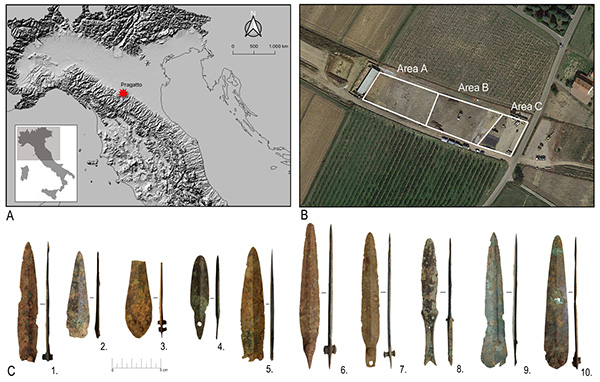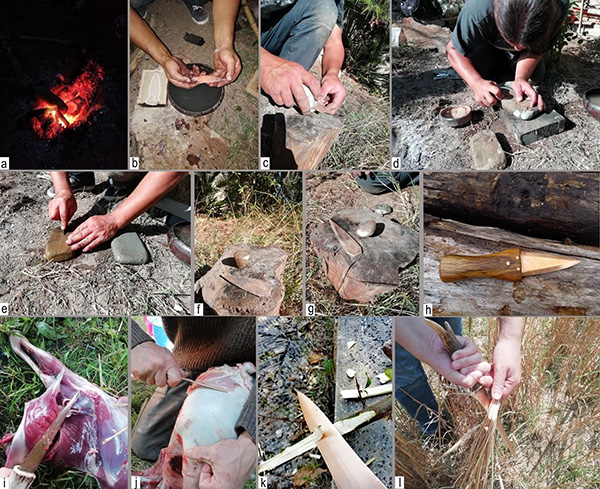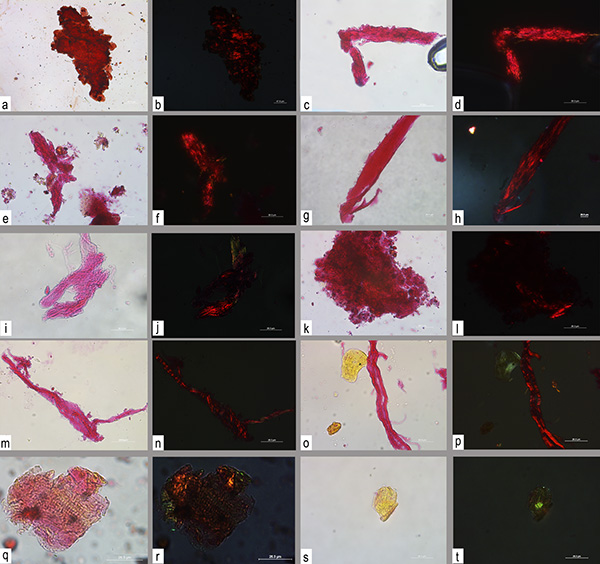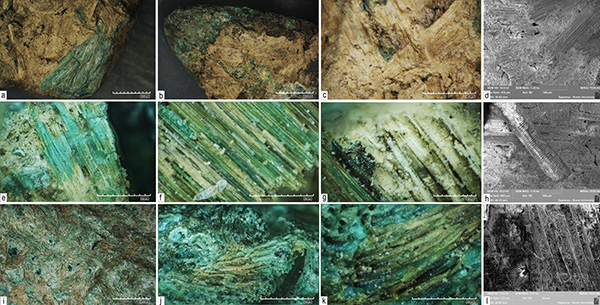Isabella Caricola and Andrea Dolfini (Newcastle University)
Introduction
Students of Chalcolithic and Bronze Age Europe have long debated the intended uses of metal weapons and tool-weapons. For most of the 20th century, the prevailing consensus was that, by and large, these objects were symbolic signifiers of male identity and power. As such, they were not deployed in combat except perhaps for the odd skirmish or duel between ‘warrior-heroes’, where performance and bravado would be more important than fighting skills in deciding the contest’s outcome. While the debate mostly centred on swords and shields, all early metal weapons were slotted into the same blanket narrative. Early Bronze Age daggers and halberds, for example, were thought to be ceremonial insignia of status due to perceived weaknesses in their alloy composition and hafting design (Avery et al. 1973; Ó Ríordáin 1937).
In the last two decades, experimental archaeology and metalwork wear analysis (an offshoot of lithic microwear analysis: Dolfini & Crellin 2016) have exposed the limits of these readings. Several studies have shown that, not only were early metal weapons designed with lethal combat in mind, but they were also used to this end, sometimes extensively (see Molloy 2017; Hermann et al. 2020 for review). Unsurprisingly, swords and shields enjoyed pride of place in this line of research, while other weapons received less attention. The dagger was perhaps the most neglected weapon (or tool-weapon) of all, which is surprising considering its early appearance (early 4th millennium BCE) and pan-European spread, from southern Scandinavia to the shores of the Mediterranean. Daggers were doubtless valued by prehistoric society, as shown by their broad diffusion and frequent placement in burials, most notably in ‘warrior graves’ (Dolfini 2022). But where exactly did the social value of these objects originate? Did it stem from the copper alloy they were made of, their shine, and/or their exoticism (Keates 2002)? Was it due to their ability to cut across cultural boundaries (Frieman 2012)? Or did it originate from use?
Thanks to generous EU funding, we set out to address these questions as part of the EuroDag project, a Horizon2020 Marie Skłodowska-Curie Fellowship carried out in 2019-21 at Newcastle University, UK. The project deployed a multi-method research approach combining (1) a wide range of use experiments with copper-alloy and flint dagger replicas; (2) the microwear analysis of c.200 prehistoric flint and metal daggers (as well as all dagger replicas used for the experiments); and (3), most innovatively, a trial application of organic residue analysis on ten freshly excavated Bronze Age daggers. The trial succeeded beyond our wildest expectations, shedding new light on how early metal daggers were used, for what tasks they were used, and the materials which they were used to cut. The research was recently published in Nature: Scientific Reports (Caricola et al. 2022).
The daggers in context
Recent excavations from Pragatto, an expansive domestic site near Bologna, Italy, provided the opportunity to test the new method. Pragatto is part of the broader Terramare settlement system, which characterised human occupation of the Po Valley in the Middle and Late Bronze Age, c.1650-1200 BCE (Miari et al. 2019). The Terramare system emerged in the early stages of the Middle Bronze Age due to combined demographic growth, likely population transfer from Alpine lake-side villages, and a novel ability to manage wet and riverine landscapes, which in turn enabled large-scale cultivation of heavy alluvial soils. Terramare sites are square villages ranging from 1 to 20 hectares in size. They were normally built near rivers or streams, whose courses were diverted to fill the ditches surrounding the villages. Embankments and palisades also encircled most sites (Nicolis 2013).
At Pragatto, controlled excavations investigated a 6,900 m2 area corresponding to the southern portion of the Bronze Age village and surrounding ditch and banks. See Figure 14 A-B. An old fieldwork adage maintains that past misfortunes are the modern archaeologist’s golden goose (think Pompeii!), and Pragatto is no exception. In this case, the golden egg consisted of a large fire that swept through the prehistoric village, thereby preserving the remains of nine houses and several animal pens, as well as other features. The fire also led the villagers to abandon over 150 bronzes on site, including daggers, arrowheads, and various craft tools.

Figure 14A. Site location; 14B. Aerial view of the site highlighting excavation areas A, B and C (source: Google Earth); 14C. Copper-alloy daggers analysed as part of the research. Specimen 1) no 1617; 2) no 2037; 3) no 175; 4) no 1707; 5) no 2041; 6) no 1798; 7) no 2035; 8) no 1683; 9) no 1321;10) no 264.
Ten daggers from this remarkable fire-swept cache were selected for further research. See Figure 14C. The sample exemplifies the alloy compositions (i.e., copper with varying amounts of tin and no traces of arsenic or lead), blade morphologies, lengths, and hafting arrangements found in Bronze Age Italy, including leaf-shaped and triangular blades. Except for one specimen (whose bronze handle was cast with the blade), all dagger blades were riveted to handles made of organic materials which have since disappeared. Chronologically, the daggers span the period from c.1550-1250 BCE, as revealed by their find contexts and distinctive morphologies.
Experiments, residue extraction and analysis
We asked experimental archaeologist and bronzesmith Alberto Rossi to prepare eight replica daggers based on Chalcolithic and Bronze Age templates, including blade geometries similar to the Pragatto specimens. He cast three daggers from 4% tin-bronze (a compositional proxy for Early to Middle Bronze Age low-tin alloys) and five daggers from 10% tin-bronze (reflecting Middle to Late Bronze Age high-tin alloys). He then hammer-hardened all replicas, hafted them, and sharpened their cutting edges with a whetstone.
Subsequently, one of these authors (IC) set out to use the replicas for cutting, scraping, and drilling activities lasting 3-5 hours each. She used four daggers to process animal bone, tendons, muscles, and cartilage; she then isolated the residues on the objects and described them through microscopic observation. Two daggers were used for butchering and carving the carcass of a pig (Sus scrofa) and of a red deer (Cervus elaphus); this helped document associations between residues. The final two daggers were used to work green and dry wood and harvest Triticum monococcum and Triticum dicoccum wheat. See Figure 15. Seven to ten days after use, we observed oxidation structures appearing on top of the plant and animal residues, ranging in colour from orange/green to black. Microscopic observation and analysis focused on these structures.

Figure 15. Production and use of bronze dagger replicas. a-h) dagger production including: (a-b) copper melting; (c) hammering of the cutting edges; (d-g) abrasion and polishing of the dagger surface; (h) the finished dagger; i-l) experimental uses of the dagger replicas, namely: (i) butchering; (j) hide scraping; (k) woodworking; (l) cereal harvesting. Photographs by I. Caricola.
The dagger replicas were analysed at the Wolfson Archaeological Laboratory, Newcastle University, and at the Department of Engineering, Sapienza University of Rome, using a range of optical microscopes and a Scanning Electron Microscope equipped with EDX microprobe for elemental analysis. The same procedure was employed for the ten daggers from Pragatto. Following Stephenson (2015), we developed a micro-residue sampling and observation protocol using the Picro-Sirius Red Solution (PSR) biochemical stain (used in histology to stain biological tissues and collagen from millennia-old archaeological contexts; Croft 2021; Montes et al. 1985). Further details of the protocol employed for organic residue extraction and characterisation are given in Caricola et al. (2022).

Figure 16. Archaeological residues observed in transmitted and cross-polarized light with staining compound PSR. a-b) sheets collagen with an angular outline; b-f) amorphous compact residues with a rough/cratered surface and peripheral crystalline fragments; g-h) tissue with longitudinal grooves; i-p) bundles of fibre; q-r) striated muscle tissue; s-t) amorphous matter.

Figure 17. Residues observed on the copper-alloy daggers from Pragatto, interpreted as remnants of sheaths. a-h) specimen no 2037 observed under an RH-Hirox digital microscope displays intertwined plant fibres tentatively interpreted as alder (Alnus sp.); (h) SEM imaging of sample no 2037 highlights details of the xylem plant cells and water-conducting tissues; i-l) specimen no 1707 observed with an RH-Hirox digital microscope displays residues of non-determined fur fibres; l) details of the negative cast of the animal fur residues as observed with a SEM microscope. Images by I. Caricola.
Research results
Microscopic observation and SEM-EDX analysis revealed traces of organic residues preserved on the cutting edges, blades, and hafting plates (or tangs) of the dagger replicas. Using PSR as a staining agent allowed us to identify micro-residues of collagen and associated bone, muscle, and tendon bundle fibres, suggesting that the daggers had come into contact with multiple animal tissues. SEM observation showed that the residues were clustered along the cutting edges and at the junction between dagger blade and hafting plate/tang. The residues were mostly trapped within metal corrosion products and striations sited on cutting edges. We interpret the striations as use traces. This interpretation is supported by SEM-EDX analysis of the residues extracted from the archaeological daggers from Pragatto. The analysis revealed abundant hydroxyapatite, a calcium phosphate present in the mineral fraction of bone.
We were able to identify the following organic residues on eight out of ten archaeological daggers. See Figure 16 for collagen including striated muscle tissue, bone tissues, and fibre bundles; and Figure 17 residues of fur/hair fibres and plant material, which we interpret as remnants of dagger sheaths. We could not determine the species of the fur/hair (solely found on one dagger) due to extensive mineralisation of the residues. As for the plant material (observed on three specimens), it was extracted and subjected to botanical analysis. The analysis revealed anatomical structures that are typical of broadleaf plants; the closest match is provided by Alnus sp. (i.e., alder), although this is not a secure identification. Interestingly, the structures observed indicate that at least two species of plant were used for the dagger sheaths. The orientation of the wood elements suggests that the sheaths were built by weaving together small strips of young branches of several plant species, which were probably cut and processed whilst still fresh.
Discussion
Traditionally, Chalcolithic and Bronze Age metal daggers are mainly thought to be ceremonial implements used to signal identity. This reading is predicated upon their being placed in ‘warrior graves’ and other lavishly equipped burials. For some scholars, however, daggers were primarily designed to function as close-range weapons – a reading supported by (admittedly rare) dagger point tips embedded in human remains as well as skeletal injuries that may have been inflicted by daggers (Guilaine and Zammit 2005; Needham et al. 2017; Vaquer and Remicourt 2010). Other researchers approached the problem through use-wear analysis, which has overall revealed high rates of edge sharpening and minor edge damage that might be due to contact with soft materials. These studies also highlighted relatively high rates of curation and size reduction through repeated sharpening, which is in line with prevalent views that daggers were socially valued (and, at times, extensively used) objects (Dolfini; 2011; Iaia and Dolfini 2020; Wall 1987). None of these studies, however, revealed what early metal daggers were used for, what tasks they aided, and on what materials they were employed.
The research presented above has provided firm answers to these questions. Validated by experiments with dagger replicas, the data emerging from integrated organic-residue and SEM-EDX analysis indicate that prehistoric metal daggers were primarily used to process animal carcasses. The evidence shows interaction with both hard and soft tissues. This suggests that daggers were used for a wide range of tasks that followed (and perhaps comprised) the slaughter of livestock and game, including butchering the carcass and carving the meat from the bone (as shown by bone, tendon, and muscle residues). The evidence tallies with the use-wear studies reviewed above, which point to a widespread desire for keeping daggers sharp throughout their use lives. It is also in line with widespread indications of animal husbandry at Pragatto, as well as our own experiments, which documented how effective daggers can be in detaching soft tissue from bone.
Significantly, the interpretation proposed here is independently validated by the microwear analysis of butchered animal remains from several prehistoric sites, which display metal cut marks (Bello & Soligo 2008; Greenfield 2004). Of course, daggers may have had further functional and symbolic uses, and they probably did. In Chalcolithic and Early Bronze Age Europe, in particular, daggers might have been utilised as close-range weapons and iconic markers of gender identity. This is shown by their placement in weapon burials and their depictions on rock carvings and stelae.
Future research directions
As well as being great fun (and a mighty challenge due to COVID-19 restrictions), the project has been a resounding success. It has shown that it is possible to borrow the methods of organic residue analysis as developed on ceramics, stone, and other archaeological materials and adapt them to copper alloys. Remarkably, residue extraction was not hindered by surface corrosion – that near-inescapable feature of old metal artefacts – but was rather enabled by it. This is because oxidised structures act as a trap for residues, which are preserved for posterity within the degraded and mineralised surface of the object. This is excellent news for archaeologists. It means that the analytical protocol developed for the Pragatto daggers can be replicated at will and deployed on any copper-alloy artefacts from anywhere in the world.
If you are thinking, “this is too good to be true”, please be aware that, unfortunately, there is a catch! At present, residues can only be extracted from freshly excavated metals that have not been contaminated through extensive handling, storage, cleaning, and conservation. Therefore, the large numbers of prehistoric and early historic bronzes filling the display cases of European museums cannot (yet?) be analysed in this way. Although this is not fundamentally different to other applications of organic residue analysis, metals are, of course, much rarer finds than are flint or potsherds. Therefore, opportunities to analyse them must not be wasted. The take-home message for all researchers interested in addressing functional problems through organic residue analysis is this: do not rush to clean or conserve your metals, as by doing so you may lose irreplaceable data. Instead, place the object in a clear clean bag and leave on any soil that might be sticking to the object. Please monitor the object and bag for condensation development (which should be avoided as much as possible) and send it off to a specialist as soon as you can – you will not regret it!
Acknowledgements
We are greatly indebted to the many colleagues that contributed their time and subject knowledge to the research. They are: Alasdair Charles, Jacopo Tirillò, Fraser Charlton, Huw Barton, Francesco Breglia, Alberto Rossi, Maria Chiara Deflorian, Anna Maria De Marinis, Susanna Harris, Alessio Pellegrini, Federico Scacchetti, Paolo Boccuccia, and Monica Miari. We also thank Isabel Arce-Garcia for preparing the samples and Cristina Lemorini for liberally allowing access to Sapienza University’s laboratories during the pandemic.
N.B. If you are interested in extracting residues from freshly excavated copper alloys, please contact isabella.caricola@ncl.ac.uk. For Chalcolithic and Bronze Age awls and other craft tools, please contact andrea.dolfini@ncl.ac.uk. A charge would normally apply. However, we might be able to analyse selected objects free of charge. Enquiries are welcome.
References
- Avery D.H., Grossman V.V., Eaton E.R. Metallurgical analysis of copper and bronze objects in Buccino: The Eneolithic Necropolis of S. Antonio and Other Discoveries Made in 1968 and 1969 by Brown University, R. Ross Holloway, Ed. (Rome: De Luca, 1973), pp. 113-114.
- Bello S. M., Soligo C. A new method for the quantitative analysis of cutmark micromorphology. Journal of Archaeological Science, 35(6), 1542-1552 (2008).
- Caricola, I., Charles, A., Tirillò, J., Charlton, F., Barton, H., Breglia, F., Rossi, A., Deflorian, M.C., De Marinis, A.M., Harris, S., Pellegrini, A., Scacchetti, F., Boccuccia, P., Miari, M. and Dolfini, A. Organic residue analysis reveals the function of Bronze Age metal daggers. Nature: Scientific Reports (2022). https://doi.org/10.1038/s41598-022-09983-3
- Croft S. Lithic Residues Analysis (Oxford: British Archaeological Reports, 2021).
- Dolfini A. The function of Chalcolithic metalwork in Italy: An assessment based on use-wear analysis. Journal of Archaeological Science, 38(5), pp. 1037-1049 (2011).
- Dolfini A. Warrior Graves Reconsidered: Metal, Power and Identity in Copper Age Italy. World Archaeology (2022). https://doi.org/10.1080/00438243.2021.2013307
- Dolfini, A. and Crellin, R.J. Metalwork wear analysis: The loss of innocence. Journal of Archaeological Science, 66, pp. 78-87 (2016).
- Frieman C.J. Innovation and Imitation: Stone skeuomorphs of metal from 4th-2nd millennia BC northwest Europe (Oxford: Archaeopress, 2012).
- Greenfield H. J. The butchered animal bone remains from Ashqelon, Afridar-Area G. Antiqot, 45, pp. 243-261(2004).
- Guilaine J., Zammit J. The Origins of War: Violence in prehistory (Malden, MA: Blackwell, 2005).
- Hermann, R., Dolfini, A., Crellin, R.J., Wang, Q. and Uckelmann, M. Bronze age swordsmanship: New insights from experiments and wear analysis. Journal of Archaeological Method and Theory, 27(4), pp. 1040-1083 (2020).
- Iaia C., Dolfini A. Manufatti eneolitici in lega di rame dall’area di Roma: un’indagine su tracce di processi tecnologici e di usura, in, Roma prima del mito. Abitati e necropoli dal neolitico alla prima eta’ dei metalli nel territorio di Roma (VI-III millennio a.C.), vol. 2, A.P. Anzidei, G. Carboni, Eds. (Oxford: Archaeopress, 2020) pp. 549-568.
- Keates S. The flashing blade: copper, colour and luminosity in North Italian Copper Age society, in Colouring the past: The Significance of Colour in Archaeological Research, A. Jones, G. MacGregor, Eds. (Oxford, UK. Berg, 2002) pp. 109-125.
- Miari M., Boccuccia P., Barbieri M., Bosi G., Carra M.L., Cremaschi M., Curci A., De Angelis A., Gabusi R., Lemorini C., Maini E., Mariani G.S., Mercuri A.M., Pavia F., Scacchetti F., Stellacci S. Gli scavi alla Terramara di Pragatto (BO): dai primi dati al progetto di ricerca, in Atti del Convegno di Studi in onore di Maria Bernabò Brea, M. Maffi, L. Bronzoni, P. Mazzieri, P., Eds. (Piacenza: Archeotravo Cooperativa Sociale, 2019), pp. 229-239.
- Molloy B. Hunting warriors: the transformation of weapons, combat practices and society during the Bronze Age in Ireland. European Journal of Archaeology, 20(2), pp.280-316 (2017).
Montes G. S., Krisztan R. M., Junqueira L. C. U. Preservation of elastic system fibers and of collagen molecular arrangement and stainability in an Egyptian mummy. Histochemistry, 83(2), pp. 117-119 (1985).
- Needham S., Kenny J., Cole G., Montgomery J., Jay M., Davis M., Marshall P. Death by combat at the dawn of the Bronze Age? Profiling the dagger-accompanied burial from Racton, West Sussex. The Antiquaries Journal, 97, pp. 65-117 (2017).
- Nicolis F. Northern Italy, in The Oxford Handbook of the European Bronze Age, H. Fokkens, A. Harding, Eds. (Oxford: Oxford University Press, 2013), pp. 693-705.
- Ó Ríordáin S.P. The halberd in Bronze Age Europe: A study in prehistoric origins, evolution, distribution, and chronology. Archaeologia, 86, pp. 195-321 (1937).
- Stephenson B. A modified Picro-Sirius Red (PSR) staining procedure with polarization microscopy for identifying collagen in archaeological residues. Journal of Archaeological Science, 61, pp. 235-243 (2015).
- Vaquer J., Remicourt M. Les poignards en cuivre et les poignards en silex dans les dotations funéraires chalcolithiques du midi de la France, in Sépultures collectives et mobiliers funéraires de la fin du Néolithique en Europe occidentale (Carcassonne, France., 2010), pp. 238-271.
- Wall J. The role of daggers in Early Bronze Age Britain: The evidence of wear analysis. Oxford Journal of Archaeology, 6(1), pp. 115-118 (1987).
Go back to top